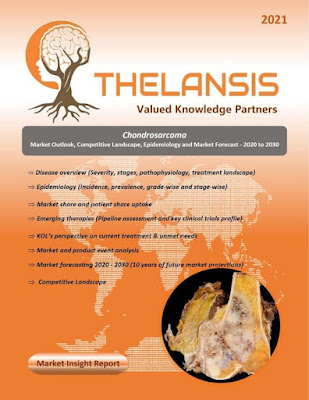Rhabdomyosarcoma (RMS) – Market Outlook, Epidemiology, Competitive Landscape, and Market Forecast Report – 2023 To 2033
Rhabdomyosarcoma
(RMS) is the most common soft-tissue sarcoma in children. RMS can occur
anywhere in the body, including the head and neck, genitourinary organs,
extremities, and abdomen. Although still debated, evidence suggests that RMS
arises from the mesenchymal cell lineage, which is typically fated to become
skeletal muscle tissue. RMS is traditionally classified into two major
histological subtypes, embryonal RMS (ERMS) and alveolar RMS (ARMS), of which
60–70% of cases are ERMS and 20–30% are ARMS. 80% of ARMS cases are defined by
a chromosomal translocation between PAX3 or PAX7 and FOXO1 genes; these
translocations result in fusion genes that largely drive oncogenic activity.
The other 20% of ARMS cases are similar to ERMS in terms of clinical outcomes
and the pattern of somatic mutations. Despite the clinical significance of RMS,
the underlying etiologies remain the environmental and genetic factors
individually contribute to this malignancy.
·
Approximately 50% of all pediatric soft-tissue
sarcoma diagnoses are Rhabdomyosarcoma with an incidence of approximately 4.71
per million children and adolescents less than 20 years of age in the United
States.
Thelansis’s
“Rhabdomyosarcoma (RMS) Market Outlook, Epidemiology, Competitive Landscape,
and Market Forecast Report – 2023 To 2033" covers disease overview,
epidemiology, drug utilization, prescription share analysis, competitive
landscape, clinical practice, regulatory landscape, patient share, market
uptake, market forecast, and key market insights under the potential Rhabdomyosarcoma
(RMS) treatment modalities options for eight major markets (USA, Germany,
France, Italy, Spain, UK, Japan, and China).
KOLs insights of Rhabdomyosarcoma
(RMS) across 8 MM market from the centre of Excellence/ Public/ Private
hospitals participated in the study. Insights around current treatment
landscape, epidemiology, clinical characteristics, future treatment paradigm,
and Unmet needs.
Rhabdomyosarcoma
(RMS) Market Forecast Patient Based Forecast Model (MS. Excel Based
Automated Dashboard), which Data Inputs with sourcing, Market Event, and
Product Event, Country specific Forecast Model, Market uptake and patient share
uptake, Attribute Analysis, Analog Analysis, Disease burden, and pricing
scenario, Summary, and Insights.
Thelansis Competitive Intelligence (CI) practice
has been established based on a deep understanding of the pharma/biotech
business environment to provide an optimized support system to all levels of
the decision-making process. It enables business leaders in forward-thinking
and proactive decision-making. Thelansis supports scientific and commercial
teams in seamless CI support by creating an AI/ ML-based technology-driven
platform that manages the data flow from primary and secondary sources.
Tags: Rhabdomyosarcoma
(RMS), Rhabdomyosarcoma (RMS) market outlook, Rhabdomyosarcoma
(RMS) competitive landscape, Rhabdomyosarcoma
(RMS) market forecast, Thelansis, Primary market
research, KOL insights, Competitive Intelligence (CI)



Comments
Post a Comment